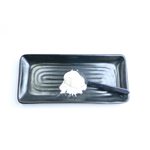Chemical Properties
Triethylenediamine also known as DABCO or TEDA, is a highly symmetrical molecule with a cage structure. The colorless extremely hygroscopic crystals is a highly nucleophilic tertiary amine base, which is used as a catalyst and reagent in polymerization and organic synthesis.
Uses
1,4-Diazabicyclo[2.2.2]octane is used as polyurethane catalyst, Balis-Hillman reaction catalyst complexing ligand and lewis base. It finds use in dye lasers and in mounting samples for fluorescence microscopy and as anti-fade reagent shown to scavenge free radicals due to flurochrome excitation of fluorochromes. Further, it is an oxidation and polymerization catalyst.
Uses
An anti-fade reagent shown to scavenge free-radicals due to flurochrome excitation.
Definition
ChEBI: Triethylenediamine is an organic heterobicylic compound that is piperazine with an ethane-1,2-diyl group forming a bridge between N1 and N4. It is typically used as a catalyst in polymerization reactions. It has a role as a catalyst, a reagent and an antioxidant. It is a bridged compound, a tertiary amino compound, a saturated organic heterobicyclic parent and a diamine.
Preparation
Triethylenediamine can be produced from ethylenediamine or ethanolamine, diethanolamine, or diethylenetriamine with a variety of different catalysts.
Reactions
Triethylenediamine reacts virtually quantitatively with bromine to give a 1/1 adduct. With alkyl halides it forms quaternary salts, even in nonpolar solvents. Apart from its highly nucleophilic nature, triethylenediamine exhibits catalytic activity in base-catalyzed reactions.
General Description
Dabco
?33-LV (Db) is a gelling catalyst and a bidentate ligand that forms a self-assembled monolayer (SAM) on a variety of substrates. It functionalizes the surface and immobilizes the surface atoms.
Flammability and Explosibility
Flammable
Purification Methods
DABCO crystallises from 95% EtOH, pet ether or MeOH/diethyl ether (1:1). Dry it under vacuum over CaCl2 and BaO. It can be sublimed in vacuo, and readily at room temperature. It has also been purified by removal of water during azeotropic distillation of a *benzene solution. It is then recrystallised twice from anhydrous diethyl ether under argon, and stored under argon [Blackstock et al. J Org Chem 52 1451 1987]. [Beilstein 23/3 V 487.]
Toxics Screening Level
The ITSL for Triethylenediamine is 6 μg/m3 annual average.







